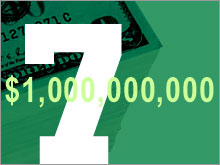7 ways to join the billion-dollar club
Small companies that grow to chalk up huge sales share seven key traits.
What does it take for a company to hit $1 billion in sales? It's a rare feat, says David Thomson, who spent three years studying exactly what it takes for a startup to reach that milestone, and published the results in his new book Blueprint to a Billion. In fact, just 387 of 7,454 U.S.-based corporations (5 percent) that went public after 1980 had achieved that magic revenue threshold by 2004 (another 49 firms hit a billion in sales last year). All of them followed a similar plan for growth, Thomson found.
Nearly all these companies - which Thomson dubbed Blueprint companies - grew exponentially after reaching a threshold of around $50 million in annual revenues. Then their sales soared in a steep curve, typically reaching $1 billion in four to 12 years, Thomson says. And unlike the VC-fuelled dot-bombs of the late 1990s, most Blueprint companies were profitable from an early stage. They also rewarded their shareholders: At the end of 2005, 60 of the top 100 performers on the NASDAQ were Blueprint companies. After interviewing dozens of executives at billion-dollar firms, Thomson boiled down their management practices to a list that he calls the Seven Essentials. Some of these principles are strategic, some are operational, and others involve leadership. They are: 1. Create and sustain a breakthrough value proposition. Some Blueprint companies (Microsoft (Research), Genentech (Research)) create an entirely new market for their products and services. Others redefine an existing market: Starbucks (Research) didn't invent coffee, but it did figure out that customers would pay more for it if it was served in comfy surroundings and marketed as an affordable luxury. A third group of companies simply sucks all the oxygen out of a market by underpricing the competition (Staples, Home Depot (Research)). 2. Exploit a high-growth market. It's kind of tough to hit a billion in sales if the total demand for your product doesn't exceed a billion dollars. That helps explain why the more than $180-billion specialty store market (which includes everything from AutoZone to Williams-Sonoma) generated a whopping 19 Blueprint companies as of 2005, followed by property and casualty insurance (16 companies) and health care facilities (12 companies). 3. Focus relentlessly on cash flow. Unlike the VC-bloated dot-bombs of the bubble era, Blueprint companies tend to be profitable from a very early stage. As a result they are able to finance their own growth at less cost than competitors who take on debt or give up equity to investors. 4. Leverage big-brother alliances. In their early days, most Blueprint companies found a major corporate partner whose high profile and reputation opened doors to new markets. Microsoft, for example, was just another garage startup until IBM (Research) outsourced its first PC operating system to a young programmer named Bill Gates. 5. Pack your board with industry experts. Most startups populate their boards with insiders or with investors who want to keep an eye on their money. But because Blueprint companies tend to finance their own growth, they are able to stack their boards with successful CEOs and market experts who offer deep experience and help bring in business. 6. Use marquee customers to build credibility. The best customers become an extension of your sales force. Cisco's (Research) first major customer was Solomon Brothers, the blue-chip Wall Street brokerage house. More recently, medical software developer Cerner enlisted physicians and IT staff from several major hospitals to man its booth at an industry trade show. 7. Build an inside-outside leadership team. "Dynamic duos are the stuff of corporate legend: Sears and Roebuck, Roy and Walt Disney, Hewlett and Packard, and the like," writes Thomson. In most such partnerships, one leader concentrates on internal operations while the other leader represents the company for clients and investors. Although much of this advice might seem like common sense, it's based on hard quantitative evidence. After three years of research, Thomson found that 90% of all Blueprint companies followed at least five of his seven essentials. Next: See the list of 49 superstars batting a billion. Plus: Six fast-growing companies that may be next.
Quiz: Could you build a billion-dollar biz? |
| |||||||||||||||


